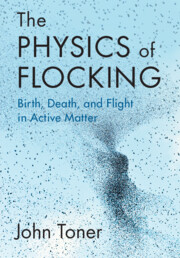Refine search
Actions for selected content:
8126 results in Fluid dynamics and solid mechanics
Chapter 2 - Fluid Modeling: Ideal Fluid Theory
- from Part I - Frequency Domain Dynamics
-
- Book:
- Introduction to Marine Dynamics
- Published online:
- 31 October 2024
- Print publication:
- 30 May 2024, pp 21-40
-
- Chapter
- Export citation
ELECTRO-OSMOTIC EFFECT ON PERISTALTIC FLOW OF PHAN–THIEN–TANNER FLUID IN A PLANAR CHANNEL
- Part of
-
- Journal:
- The ANZIAM Journal / Volume 66 / Issue 1 / January 2024
- Published online by Cambridge University Press:
- 24 May 2024, pp. 77-97
-
- Article
- Export citation
Dedication
-
- Book:
- The Physics of Flocking
- Published online:
- 16 May 2024
- Print publication:
- 23 May 2024, pp v-vi
-
- Chapter
- Export citation
4 - Formulating the Hydrodynamic Model for Flocking
-
- Book:
- The Physics of Flocking
- Published online:
- 16 May 2024
- Print publication:
- 23 May 2024, pp 88-116
-
- Chapter
- Export citation
Frontmatter
-
- Book:
- The Physics of Flocking
- Published online:
- 16 May 2024
- Print publication:
- 23 May 2024, pp i-iv
-
- Chapter
- Export citation
7 - Heuristic Argument for the Canonical Exponents (“20-20 Hindsight Hand-Waving Argument”)
-
- Book:
- The Physics of Flocking
- Published online:
- 16 May 2024
- Print publication:
- 23 May 2024, pp 135-139
-
- Chapter
- Export citation
2 - Dynamical Derivation (and a More Conventional One) of the Mermin–Wagner–Hohenberg Theorem; or, Why We Can’t All Point the Same Way
-
- Book:
- The Physics of Flocking
- Published online:
- 16 May 2024
- Print publication:
- 23 May 2024, pp 9-29
-
- Chapter
- Export citation
Index
-
- Book:
- The Physics of Flocking
- Published online:
- 16 May 2024
- Print publication:
- 23 May 2024, pp 238-242
-
- Chapter
- Export citation
6 - Incompressible Polar Active Fluids in the Moving Phase in Dimensions d > 2: the “Canonical” Exponents
-
- Book:
- The Physics of Flocking
- Published online:
- 16 May 2024
- Print publication:
- 23 May 2024, pp 121-134
-
- Chapter
- Export citation
3 - The Dynamical Renormalization Group; or, WhyWe Can Do Physics, Illustrated by the KPZ Equation
-
- Book:
- The Physics of Flocking
- Published online:
- 16 May 2024
- Print publication:
- 23 May 2024, pp 30-87
-
- Chapter
- Export citation
8 - Incompressible Flocks in Spatial Dimensions d = 2: Mapping to the KPZ Equation
-
- Book:
- The Physics of Flocking
- Published online:
- 16 May 2024
- Print publication:
- 23 May 2024, pp 140-163
-
- Chapter
- Export citation
Preface
-
- Book:
- The Physics of Flocking
- Published online:
- 16 May 2024
- Print publication:
- 23 May 2024, pp xi-xiv
-
- Chapter
- Export citation
Acknowledgments
-
- Book:
- The Physics of Flocking
- Published online:
- 16 May 2024
- Print publication:
- 23 May 2024, pp xv-xvi
-
- Chapter
- Export citation
5 - The Dynamical Renormalization Group Applied to the Flocking Problem
-
- Book:
- The Physics of Flocking
- Published online:
- 16 May 2024
- Print publication:
- 23 May 2024, pp 117-120
-
- Chapter
- Export citation
1 - Introduction and Motivation: Are Birds Smarter Than Nerds?
-
- Book:
- The Physics of Flocking
- Published online:
- 16 May 2024
- Print publication:
- 23 May 2024, pp 1-8
-
- Chapter
- Export citation
Contents
-
- Book:
- The Physics of Flocking
- Published online:
- 16 May 2024
- Print publication:
- 23 May 2024, pp vii-x
-
- Chapter
- Export citation
Bibliography
-
- Book:
- The Physics of Flocking
- Published online:
- 16 May 2024
- Print publication:
- 23 May 2024, pp 231-237
-
- Chapter
- Export citation
9 - “Malthusian” Flocks (Flocks with Birth and Death)
-
- Book:
- The Physics of Flocking
- Published online:
- 16 May 2024
- Print publication:
- 23 May 2024, pp 164-230
-
- Chapter
- Export citation

The Physics of Flocking
- Birth, Death, and Flight in Active Matter
-
- Published online:
- 16 May 2024
- Print publication:
- 23 May 2024
INDEX
-
- Journal:
- The ANZIAM Journal / Volume 65 / Issue 4 / October 2023
- Published online by Cambridge University Press:
- 10 May 2024, pp. 411-412
-
- Article
- Export citation


